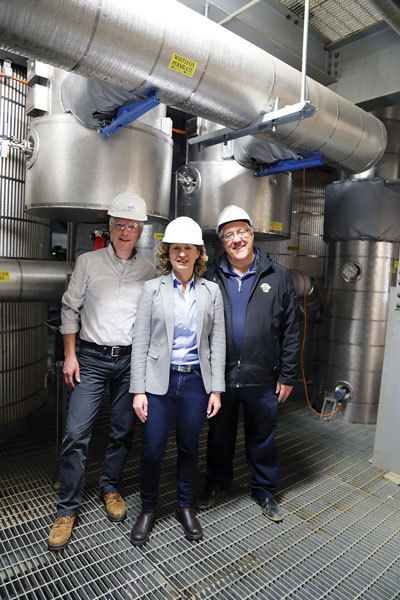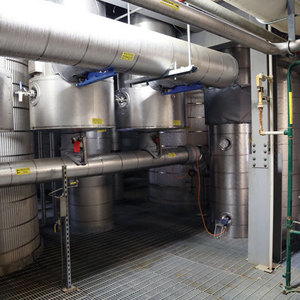Outfoxing dehydration



PHOTO: TIM PORTZ, BBI INTERNATIONAL
June 15, 2017
BY Tim Portz
Every day in the ethanol industry, millions of gallons of finished, dehydrated ethanol is combined with water and flushed through the process from which it just emerged, moving back one whole step. Producers do this because the dehydration process for their post-distillation water/ethanol mix requires it.
The zeolite beads at the heart of the molecular sieve used for dehydration resemble frozen grey peas. These beads have a strong affinity for water, collecting it as the water/ethanol passes through them and leaving nearly pure ethanol. The challenge is that, like a sponge, zeolite beads have a finite capacity to attract and hold water, and must be periodically purged of accumulated water. This is accomplished by reversing the process and pushing ethanol back through the beads. The water and ethanol mix that emerges from that regeneration step is reintroduced to the plant’s distillation column and the distillation and dehydration process begins again. The ethanol required to purge the molecular sieves can be thought of as a plant’s dehydration parasitic load.
“Plants often have between 20 to 30 percent of their production assets tied up in regeneration,” says Gillian Harrison, CEO of Whitefox Technologies Ltd., based in London. The volume of ethanol recycled through plant molecular sieves across the industry is approaching 10 million gallons per day. Harrison stresses that they are finished, saleable gallons that are returned to the process because of the limitations of the best-available technology, until now.
“When we talk to producers and they start really thinking about the bottleneck their current molecular sieves create with the recycle streams, you sense that they get frustrated with this inefficiency,” she says. Harrison goes on to note that many of the process improvements being made upstream in ethanol plants are getting stuck behind this same bottleneck. “All those yield enhancements that are being deployed right now all go nowhere,” she says.
Continuous Dehydration
Whitefox Technologies’ integrated cartridge efficiency (ICE) technology requires no regeneration cycle, by virtue of its design and the specific attributes of its unique membrane. The technology relies on a collection of thousands of tiny tubes, about the diameter of angel hair pasta, made entirely of a hydrophilic membrane. As a mix of ethanol and water pass through these tubes, water is absorbed into the wall of the membrane and a slight vacuum pulls the water through. The ethanol in the mix is resistant to the membrane and exits the tube as an extremely dry ethanol.
Harrison introduced a laboratory-scale cartridge to North American producers at the International Fuel Ethanol Workshop in 2014. When the stainless steel housing is opened, the mass of tube membranes resembles a bundle of electrical wires. In Harrison’s lab-scale model, about 50 tubes are bundled together. She says each module at Pine Lake Corn Processors has 50,000.
“One of the first things people always offer when I tell them our approach is a membrane technology is that the surface area requirement would simply be too great to be practical at their scale,” says Paul Kamp, an ethanol industry veteran now working with Harrison to introduce the technology to the North American market. According to Kamp, this objection is right, but producers need only see the inside of the lab-scale model to understand that the tubes meet the surface area requirement without gobbling up precious plant real estate. “Bingo. Surface area problem solved,” says Kamp, gesturing to the lab scale’s neatly and tightly bound membrane tubes.
The Road to Steamboat Rock
Today, Whitefox Technologies’ membrane dehydration technologies have found a foothold at two facilities. In January 2016, Whitefox Technologies announced it had agreed with Pacific Ethanol to install its first U.S. commercial system in Madera, California. In February 2016, Whitefox announced it had landed its first customer in Iowa—Pine Lake Corn Processors just north of tiny Steamboat Rock in Hardin County.
Before 2013, the technology was virtually unknown to North American ethanol producers. Originally developed by Stephan Blum in Germany, the technology was used to reclaim process solvents in the cosmetics industry. Blum appreciated the technology’s ability to separate water from ethanol and recognized it could have other, much larger applicability. Blum knew he needed to develop a turnkey solution. Initially, Whitefox took the technology to Brazil where harsh chemical treatments (benzene and cyclohexane) were used to separate water from ethanol. Blum and Whitefox went to work on learning the engineering realities of industrial-scale ethanol manufacturing.
“A large-scale biofuels plant is completely different than a small facility making industrial fuel ethanol at much smaller volumes,” Harrison says. “Smaller systems have more controls, higher levels of input purity, less issues in terms of mash. All of the things that simply come along with large-scale ethanol production, you just wouldn’t have to deal with at a small-scale facility.”
The global financial crisis in 2008-’09 slowed commercialization progress for Whitefox, and with the subsequent economic collapse in Brazil, the company set its sights on the North American market. The team began talking to producers in 2012, and attended its first FEW in 2014. The initial reactions to the technology wasn’t surprising. “You inevitably would hear people talk about fragility of the membrane,” Kamp says. “Other objections were the amount of new piping that producers assumed would be required, or that the maintenance involved in keeping the system up and operational would simply cripple them. Honestly, those are all of the same thoughts I had when I first heard about the technology and why I continue to be drawn to it. These are all honestly nonissues. We find that operators seldom even inspect these modules, they just run and run and run.”
First Things First
At Pine Lake Corn Processors, Whitefox Technology finds itself in the middle of a complete plant overhaul and expansion. The original facility, designed by Delta-T and built in 2005, had an installed capacity of 35 million gallons. Today, the site at Pine Lake is loaded with contractor vehicles as another 40 million gallons of capacity is installed. The new facility, an ICM design, will be built around the existing facility and will incorporate the Whitefox ICE solutions to handle the side streams from the new molecular sieve units.
In February, Whitefox Technologies announced the plant would expand the solution by one-third. Pine Lake Corn Processors CEO James Broghammer said in the news release, “The impact of the Whitefox ICE became evident almost immediately. Overall, I see a better-performing plant with increased capacity and lower steam consumption per gallon of ethanol produced, just by eliminating the mole sieve recycle stream to the rectifier.”
With the success of the installation at Pine Lake, coupled with the expansion, is the team tempted to make the leap to complete dehydration by the ICE technology exclusively? “Quite a few producers are already thinking like that, and are asking about that,” Harrison says. “In Europe, this is how dehydration is done. For now, however, we’re all about the stepping-stone approach. It has always been the goal of Whitefox Technologies and Dr. Blum to establish operator comfort with the technology, which is what we are doing now and we’re still learning from this installation.”
If the visitor’s log at Pine Lake is any indication, Whitefox Technologies is well on its way to achieving widespread operator familiarity with its technology. Harrison and Kamp are spending a good deal of time at the facility, talking to operators at the plant and welcoming curious visitors from other facilities.
“At the end of the day, producers need to remove water from their produced ethanol and we believe this approach is the logical progression in the evolution of dehydration,” Kamp says.
Other options are available to address this critical bottleneck, but none deliver the operational advantages the Whitefox ICE solution does, Kamp and Harrison say. With the other options, producers wanting to expand dehydration capacity would have to consider multiple approaches deployed together to achieve the same result.
“Plants can always add more dehydration capacity,” Harrison says. “They might even add another molecular sieve bottle. The thing producers realize once they begin to think about molecular sieves is that any capacity they add with a traditional zeolite sieve also increases the amount of ethanol they’ve got to set aside for their bead recycle step.” Distillation columns can be tweaked and repacked if producers believe they are underperforming, she notes. Additionally, another boiler might be installed to address a steam bottleneck.
“To get increased capacity, steam savings and cooling water benefits, you’d have to deploy multiple technologies, whereas the Whitefox ICE solution can deliver them in one solution,” Harrison says. “Furthermore, the ICE system completely eliminates the fluctuation that comes along with a recycle step. So long as a plant continues to utilize molecular sieves without the Whitefox system integrated into their operation, the flat, steady operational state afforded by our system just won’t be possible.”
For Pine Lake, the priority was increased capacity. “Initially, James and his team did consider simply adding another bottle of zeolite beads to remove this dehydration bottleneck,” Kamp says.
“Interestingly, deploying the ICE system was actually cheaper than simply expanding the molecular sieve unit.” Pine Lake Corn Processors is sold on the new technology. In addition to the expansion of the ICE system it already has installed on its existing production platform, it will also use ICE with the new, additional 40 million gallons of production capacity.
“The new plant that is being built was originally being described as 40 million new gallons of capacity, but now they are calling it 50, which makes sense,” Kamp says. Once the second production platform at Pine Lake is complete, the facility will be the largest deployment of the Whitefox ICE solution in the U.S. Kamp and Harrison hope the plant’s location in the heart of the industry means more producers will be tempted to visit.
In Harrison’s mind, once operators realize the inefficiency of mole sieve regen, they cannot unlearn it. If the technology continues to perform at Pine Lake Corn Processors with the success it has shown already, the plant could serve as a pivot point in the evolution of ethanol dehydration.
Author: Tim Portz
Executive Editor, Ethanol Producer Magazine
701-738-4969
tportz@bbiinternational.com
Advertisement
Advertisement
Advertisement
Advertisement
Related Stories
The USDA’s Risk Management Agency is implementing multiple changes to the Camelina pilot insurance program for the 2026 and succeeding crop years. The changes will expand coverage options and provide greater flexibility for producers.
EcoCeres Inc. has signed a multi-year agreement to supply British Airways with sustainable aviation fuel (SAF). The fuel will be produced from 100% waste-based biomass feedstock, such as used cooking oil (UCO).
SAF Magazine and the Commercial Aviation Alternative Fuels Initiative announced the preliminary agenda for the North American SAF Conference and Expo, being held Sept. 22-24 at the Minneapolis Convention Center in Minneapolis, Minnesota.
Saipem has been awarded an EPC contract by Enilive for the expansion of the company’s biorefinery in Porto Marghera, near Venice. The project will boost total nameplate capacity and enable the production of SAF.
Global digital shipbuilder Incat Crowther announced on June 11 the company has been commissioned by Los Angeles operator Catalina Express to design a new low-emission, renewable diesel-powered passenger ferry.
Upcoming Events










